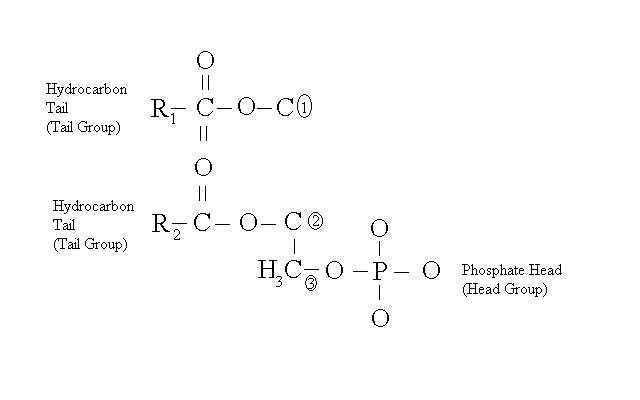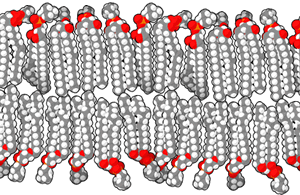Cell biology/Membrane Structure: Lipids
Here is the link to the ITunes U Lecture from Berkeley. Membrane Structure: Lipids
Textbook Recommended by Professor: Molecular Biology of the Cell, Alberts et. al.
How do we visualize a cell membrane?
- Study cells whole with electron microscopy (see picture on right). Cells are prepared through a process of fixing, embedding, slicing, and staining. Cells are then loaded into an electron microscope where they scatter electrons that are directed through them. A receptor picks up the electrons and creates a visual image since humans can not see electrons. The process of tissue preparation can cause a lot of artifacts to appear.
- Study cells whole with light microscopy (see picture on left). There have been a lot of advances in this method. In the past it was difficult to study the molecular level because it cannot be visualized through normal light microscopy. However, since the discovery of the GFP gene, from jellyfish, light microscopy is a great new tool. This new method is called fluorescence microscopy (see center picture)The GFP gene creates a green light that now comes in a range of shades. Anyhow this can be attached to an antibody and used as a real time probe in a living cell: just follow the green light. Unfortunately, the GFP gene can cause a protein to fold incorrectly and then becomes useless.
How Can We Isolate a Membrane?
- Study cells in pieces with membrane fractionation.
- This process involves taking tissue or cells and rupturing their cell membranes using a technique called vigorous homogenization (very similar to using a mortar and pestle). This produces pieces of membrane and organelles called lysate.
- Centrifuge to separate pieces which will settle at different rates: Nucleus first, Endoplasmic Reticulum last. Using centrifuging to separate cell parts is called differential centrifugation and it separates lysate according to mass.
- A sucrose gradient, a gradient is created using an increasing concentration of sucrose as you move down the centrifuge tube. When the lysate is added to this tube and centrifuged, the lysate travels to the point where it's density is matched by the surrounding sucrose.
Membrane Properties
Selective Permeability
The phospholipid membrane itself does not allow polar or charged species to flow through it. There are channels, permeases, that allow charged and polar substances entry and exit from the cell.
Oxidative Phosphorylation in Mitochondria
- Outer membrane allows passive transport of small molecules through porin (simple channel).
- Inner membrane actively transports protons from the matrix (central area) into the intermembrane space.
- ATPase is associated with a pore forming structure on inner membrane when protons are actively transported out. ATP is consumed when protons are transported out into the intermembrane space.
- However, when the gradient reverses the protons flow in from the intermembrane space into the matrix. This causes the generation of ATP from ADP.
Mechanically Deformable
Membranes can be deformed because they are fluid. Hence fluid-mosaic model. This property comes from the phospholipid bilayer. A membrane is pictured as a mosaic because it has various protein molecules embedded in the phospholipid bilayer .
Communication
Membranes serve in cell-cell communication and signal transduction in the nervous and muscular systems.
Phospholipid bilayer
The image is wrong and needs correction. too many bonds are on carbon atoms and oxygen atoms.


The head group points towards the outside of the membrane while the tail group is hydrophobic and points inward. There are some very common fatty acid side chains (R groups: R1 and R2) including:
- palmitate, 16 carbon saturated fatty acid chain.

- oleate, an 18 carbon unsaturated fatty acid chain with a single double bond.

- sterate, an 18 carbon saturated fatty acid chain.

Saturated bonds are very flexible but double bonds create kinks and limit flexibility.
Phospholipids have a amphipathic property or nonpolar and polar properties.
For more information check out: The Wikipedia Page
Please feel free to add details or make changes where necessary. Contact me via email if you need help. Thanks, April

